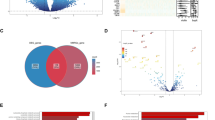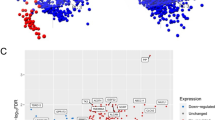Abstract
Background
Approximately 30% of patients with oestrogen receptor (ER)-positive breast cancer (BC) exhibit intrinsic or recurrent resistance to tamoxifen (TAM) adjuvant endocrine therapy. The androgen receptor (AR) is expressed in about 90% of ER-positive patients. Our previous studies found that BC patients with an AR:ER expression ratio ≥ 2.0 are more susceptible to TAM resistance. However, the specific mechanism by which a high AR:ER ratio promotes TAM resistance remains unknown.
Methods
RNA sequencing was performed on 10 cases of BC tissues with AR:ER ratios ≥ 2.0 and 3 cases with AR:ER ratios < 2.0. We then compared our data with the screened TAM-resistant and TAM-sensitive cases from the TCGA BC database. Bioinformatics methods were used to screen differentially expressed genes (DEGs) and to perform gene enrichment analysis. Weighted correlation network analysis (WGCNA) was used to screen hub genes in the AR-induced TAM resistance process.
Results
PAM50 analysis showed that the molecular phenotype of BC patients with
AR:ER ratios ≥ 2.0 was similar to that of triple-negative breast cancer (TNBC), whereas the BC samples with AR:ER ratios < 2.0 were classified as the luminal subtype. Among the AR:ER ratio ≥ 2.0 and AR:ER < 2.0 BC tumours, 1855 DEGs were identified. Gene enrichment analysis showed that DEGs were enriched mainly in proliferation-related molecular pathways, such as the cell cycle, necroptosis, metabolic pathways and DNA replication. WGCNA analysis showed that SEC14L2, RIIAD1, STC2 and MAGEA6 served as hub genes in AR-induced TAM resistance and were associated with BC survival prognosis in the TCGA cohort.
Conclusions
A high AR:ER expression ratio is a biomarker for patients who might develop TAM resistance, and AR expression seems to be a possible mechanism of resistance to endocrine therapy.





Similar content being viewed by others
References
Fan P, Jordan VC (2019) New insights into acquired endocrine resistance of breast cancer. Cancer drug resist 2:198–209. https://doi.org/10.20517/cdr.2019.13
Siersbaek R, Kumar S, Carroll JS (2018) Signaling pathways and steroid receptors modulating estrogen receptor alpha function in breast cancer. Genes Dev 32:1141–1154. https://doi.org/10.1101/gad.316646.118
Cao L, Li C, Xu C, Xiang G, Liu F, Liu X, Jiao J, Lv S, Niu Y (2018) Clinical significance of PDEF factor expression and its relation to androgen receptor in ER(-) breast cancer. Histopathology 73:819–831. https://doi.org/10.1111/his.13699
Wu Y, Vadgama JV (2017) Androgen receptor as a potential target for treatment of breast cancer. Int j cancer res mol mech. https://doi.org/10.16966/2381-3318.129
Elebro K, Bendahl PO, Jernstrom H, Borgquist S (2017) Androgen receptor expression and breast cancer mortality in a population-based prospective cohort. Breast Cancer Res Treat 165:645–657. https://doi.org/10.1007/s10549-017-4343-0
Jiang HS, Kuang XY, Sun WL, Xu Y, Zheng YZ, Liu YR, Lang GT, Qiao F, Hu X, Shao ZM (2016) Androgen receptor expression predicts different clinical outcomes for breast cancer patients stratified by hormone receptor status. Oncotarget 7:41285–41293. https://doi.org/10.18632/oncotarget.9778
Kono M, Fujii T, Lim B, Karuturi MS, Tripathy D, Ueno NT (2017) Androgen receptor function and androgen receptor-targeted therapies in breast cancer: a review. JAMA Oncol 3:1266–1273. https://doi.org/10.1001/jamaoncol.2016.4975
Hu R, Dawood S, Holmes MD, Collins LC, Schnitt SJ, Cole K, Marotti JD, Hankinson SE, Colditz GA, Tamimi RM (2011) Androgen receptor expression and breast cancer survival in postmenopausal women. Clin cancer res 17:1867–1874. https://doi.org/10.1158/1078-0432.CCR-10-2021
Castellano I, Allia E, Accortanzo V, Vandone AM, Chiusa L, Arisio R, Durando A, Donadio M, Bussolati G, Coates AS, Viale G, Sapino A (2010) Androgen receptor expression is a significant prognostic factor in estrogen receptor positive breast cancers. Breast Cancer Res Treat 124:607–617. https://doi.org/10.1007/s10549-010-0761-y
Pizon M, Lux D, Pachmann U, Pachmann K, Schott D (2018) Influence of endocrine therapy on the ratio of androgen receptor (AR) to estrogen receptor (ER) positive circulating epithelial tumor cells (CETCs) in breast cancer. J Transl Med 16:356. https://doi.org/10.1186/s12967-018-1724-z
Cochrane DR, Bernales S, Jacobsen BM, Cittelly DM, Howe EN, D’Amato NC, Spoelstra NS, Edgerton SM, Jean A, Guerrero J, Gomez F, Medicherla S, Alfaro IE, McCullagh E, Jedlicka P, Torkko KC, Thor AD, Elias AD, Protter AA, Richer JK (2014) Role of the androgen receptor in breast cancer and preclinical analysis of enzalutamide. Breast Cancer Res 16:R7. https://doi.org/10.1186/bcr3599
Cao L, Xiang G, Liu F, Xu C, Liu J, Meng Q, Lyu S, Wang S, Niu Y (2019) A high AR:ERalpha or PDEF:ERalpha ratio predicts a sub-optimal response to tamoxifen therapy in ERalpha-positive breast cancer. Cancer Chemother Pharmacol 84:609–620. https://doi.org/10.1007/s00280-019-03891-6
Ciupek A, Rechoum Y, Gu G, Gelsomino L, Beyer AR, Brusco L, Covington KR, Tsimelzon A, Fuqua SA (2015) Androgen receptor promotes tamoxifen agonist activity by activation of EGFR in ERalpha-positive breast cancer. Breast Cancer Res Treat 154:225–237. https://doi.org/10.1007/s10549-015-3609-7
Chen YC, Yu J, Metcalfe C, De Bruyn T, Gelzleichter T, Malhi V, Perez-Moreno PD, Wang X (2022) Latest generation estrogen receptor degraders for the treatment of hormone receptor-positive breast cancer. Expert Opin Investig Drugs 31:515–529. https://doi.org/10.1080/13543784.2021.1983542
Metcalf S, Petri BJ, Kruer T, Green B, Dougherty S, Wittliff JL, Klinge CM, Clem BF (2021) Serine synthesis influences tamoxifen response in ER+ human breast carcinoma. Endocr Relat Cancer 28:27–37. https://doi.org/10.1530/ERC-19-0510
Jordan VC (2021) 50th anniversary of the first clinical trial with ICI 46,474 (tamoxifen): then what happened? Endocr Relat Cancer 28:R11–R30. https://doi.org/10.1530/ERC-20-0335
Fan P, Craig Jordan V (2014) Acquired resistance to selective estrogen receptor modulators (SERMs) in clinical practice (tamoxifen & raloxifene) by selection pressure in breast cancer cell populations. Steroids 90:44–52. https://doi.org/10.1016/j.steroids.2014.06.002
Jordan VC, O’Malley BW (2007) Selective estrogen-receptor modulators and antihormonal resistance in breast cancer. J clin 25:5815–5824. https://doi.org/10.1200/JCO.2007.11.3886
Iacopetta D, Rechoum Y, Fuqua SA (2012) The role of androgen receptor in breast cancer. Drug discov today Dis mech 9:e19–e27. https://doi.org/10.1016/j.ddmec.2012.11.003
Cao L, Xu C, Xiang G, Liu F, Liu X, Li C, Liu J, Meng Q, Jiao J, Niu Y (2018) AR-PDEF pathway promotes tumour proliferation and upregulates MYC-mediated gene transcription by promoting MAD1 degradation in ER-negative breast cancer. Mol Cancer 17:136. https://doi.org/10.1186/s12943-018-0883-0
Pietri E, Conteduca V, Andreis D, Massa I, Melegari E, Sarti S, Cecconetto L, Schirone A, Bravaccini S, Serra P, Fedeli A, Maltoni R, Amadori D, De Giorgi U, Rocca A (2016) Androgen receptor signaling pathways as a target for breast cancer treatment. Endocr Relat Cancer 23:R485-498. https://doi.org/10.1530/ERC-16-0190
Rizza P, Barone I, Zito D, Giordano F, Lanzino M, De Amicis F, Mauro L, Sisci D, Catalano S, Dahlman Wright K, Gustafsson JA, Ando S (2014) Estrogen receptor beta as a novel target of androgen receptor action in breast cancer cell lines. Breast cancer res 16:R21. https://doi.org/10.1186/bcr3619
Bahnassy S, Thangavel H, Quttina M, Khan AF, Dhanyalayam D, Ritho J, Karami S, Ren J, Bawa-Khalfe T (2020) Constitutively active androgen receptor supports the metastatic phenotype of endocrine-resistant hormone receptor-positive breast cancer. Cell Commun Signal 18:154. https://doi.org/10.1186/s12964-020-00649-z
De Amicis F, Thirugnansampanthan J, Cui Y, Selever J, Beyer A, Parra I, Weigel NL, Herynk MH, Tsimelzon A, Lewis MT, Chamness GC, Hilsenbeck SG, Ando S, Fuqua SA (2010) Androgen receptor overexpression induces tamoxifen resistance in human breast cancer cells. Breast Cancer Res Treat 121:1–11. https://doi.org/10.1007/s10549-009-0436-8
Scott LJ (2018) Enzalutamide: a review in castration-resistant prostate cancer. Drugs 78:1913–1924. https://doi.org/10.1007/s40265-018-1029-9
Traina TA, Miller K, Yardley DA, Eakle J, Schwartzberg LS, O’Shaughnessy J, Gradishar W, Schmid P, Winer E, Kelly C, Nanda R, Gucalp A, Awada A, Garcia-Estevez L, Trudeau ME, Steinberg J, Uppal H, Tudor IC, Peterson A, Cortes J (2018) Enzalutamide for the treatment of androgen receptor-expressing triple-negative breast cancer. J clin 36:884–890. https://doi.org/10.1200/JCO.2016.71.3495
Chia K, Milioli H, Portman N, Laven-Law G, Coulson R, Yong A, Segara D, Parker A, Caldon CE, Deng N, Swarbrick A, Tilley WD, Hickey TE, Lim E (2019) Non-canonical AR activity facilitates endocrine resistance in breast cancer. Endocr Relat Cancer 26:251–264. https://doi.org/10.1530/ERC-18-0333
Costa R, Todt D, Zapatero-Belinchon F, Schenk C, Anastasiou OE, Walker A, Hertel B, Timmer L, Bojkova D, Ruckert M, Sarrazin C, Timm J, Lohmann V, Manns MP, Steinmann E, von Hahn T, Ciesek S (2019) SEC14L2, a lipid-binding protein, regulates HCV replication in culture with inter- and intra-genotype variations. J Hepatol 70:603–614. https://doi.org/10.1016/j.jhep.2018.11.012
Li Z, Lou Y, Tian G, Wu J, Lu A, Chen J, Xu B, Shi J, Yang J (2019) Discovering master regulators in hepatocellular carcinoma: one novel MR, SEC14L2 inhibits cancer cells. Aging 11:12375–12411. https://doi.org/10.18632/aging.102579
Zhang DD, Shi Y, Liu JB, Yang XL, Xin R, Wang HM, Wang PY, Jia CY, Zhang WJ, Ma YS, Fu D (2021) Construction of a Myc-associated ceRNA network reveals a prognostic signature in hepatocellular carcinoma. Mol ther Nucl acid 24:1033–1050. https://doi.org/10.1016/j.omtn.2021.04.019
Liu X, Peng Y, Wang J (2020) Integrative analysis of DNA methylation and gene expression profiles identified potential breast cancer-specific diagnostic markers. Biosci Rep. https://doi.org/10.1042/BSR20201053
Qie S, Sang N (2022) Stanniocalcin 2 (STC2): a universal tumour biomarker and a potential therapeutical target. J exp clin cancer res 41:161. https://doi.org/10.1186/s13046-022-02370-w
Lin C, Sun L, Huang S, Weng X, Wu Z (2019) STC2 Is a potential prognostic biomarker for pancreatic cancer and promotes migration and invasion by inducing epithelial-mesenchymal transition. Biomed Res Int 2019:8042489. https://doi.org/10.1155/2019/8042489
Zhang C, Chen S, Ma X, Yang Q, Su F, Shu X, Xie W, Feng M, Xiong B (2019) Upregulation of STC2 in colorectal cancer and its clinicopathological significance. Onco Target Ther 12:1249–1258. https://doi.org/10.2147/OTT.S191609
He H, Qie S, Guo Q, Chen S, Zou C, Lu T, Su Y, Zong J, Xu H, He D, Xu Y, Chen B, Pan J, Sang N, Lin S (2019) Stanniocalcin 2 (STC2) expression promotes post-radiation survival, migration and invasion of nasopharyngeal carcinoma cells. Cancer manag res 11:6411–6424. https://doi.org/10.2147/CMAR.S197607
Li J, Yang Z, Huang S, Li D (2020) BIRC7 and STC2 expression are associated with tumorigenesis and poor outcome in extrahepatic cholangiocarcinoma. Technol Cancer Res Treat 19:1533033820971676. https://doi.org/10.1177/1533033820971676
Ravichandran R, Kodali K, Peng J, Potts PR (2019) Regulation of MAGE-A3/6 by the CRL4-DCAF12 ubiquitin ligase and nutrient availability. EMBO Rep 20:e47352. https://doi.org/10.15252/embr.201847352
Yang B, O’Herrin SM, Wu J, Reagan-Shaw S, Ma Y, Bhat KM, Gravekamp C, Setaluri V, Peters N, Hoffmann FM, Peng H, Ivanov AV, Simpson AJ, Longley BJ (2007) MAGE-A, mMage-b, and MAGE-C proteins form complexes with KAP1 and suppress p53-dependent apoptosis in MAGE-positive cell lines. Can Res 67:9954–9962. https://doi.org/10.1158/0008-5472.CAN-07-1478
Acknowledgements
We thank the BC patients and their families. They generously donated valuable tissue samples.
Funding
This study was funded by National Natural Science Foundation of China (Grant Number 82002813), Tianjin Health Technology Project (Grant Number TJWJ2021QN010) and Tianjin Key Medical Discipline (Pathology) Construction Project (TJYXZDXK-012A).
Author information
Authors and Affiliations
Contributions
CL and ZPS designed the study; CL, LLM, HQJ and GQR performed the experiments; NY and CWF performed the statistical analysis; CL and ZPS wrote and revised the manuscript. All authors read and approved the final manuscript.
Corresponding author
Ethics declarations
Conflict of interest
The authors declare that they have no conflict of interest.
Ethical approval
All procedures performed in studies involving human participants were accordance with the ethical standards of the institutional and/or national research committee and with the 1964 Helsinki declaration and its later amendments or comparable ethical standards. This study was approved by the ethics committee at the Cancer Hospital of Tianjin Medical University (Ek2020074) and informed consent was obtained from all patients.
Informed consent
Informed consent was obtained from all individual participants included in the study.
Additional information
Publisher's Note
Springer Nature remains neutral with regard to jurisdictional claims in published maps and institutional affiliations.
Supplementary Information
Below is the link to the electronic supplementary material.
Rights and permissions
Springer Nature or its licensor (e.g. a society or other partner) holds exclusive rights to this article under a publishing agreement with the author(s) or other rightsholder(s); author self-archiving of the accepted manuscript version of this article is solely governed by the terms of such publishing agreement and applicable law.
About this article
Cite this article
Lu, C., Yang, Y., Lingmei, L. et al. Identification of hub genes in AR-induced tamoxifen resistance in breast cancer based on weighted gene co-expression network analysis. Breast Cancer Res Treat 197, 71–82 (2023). https://doi.org/10.1007/s10549-022-06788-w
Received:
Accepted:
Published:
Issue Date:
DOI: https://doi.org/10.1007/s10549-022-06788-w




